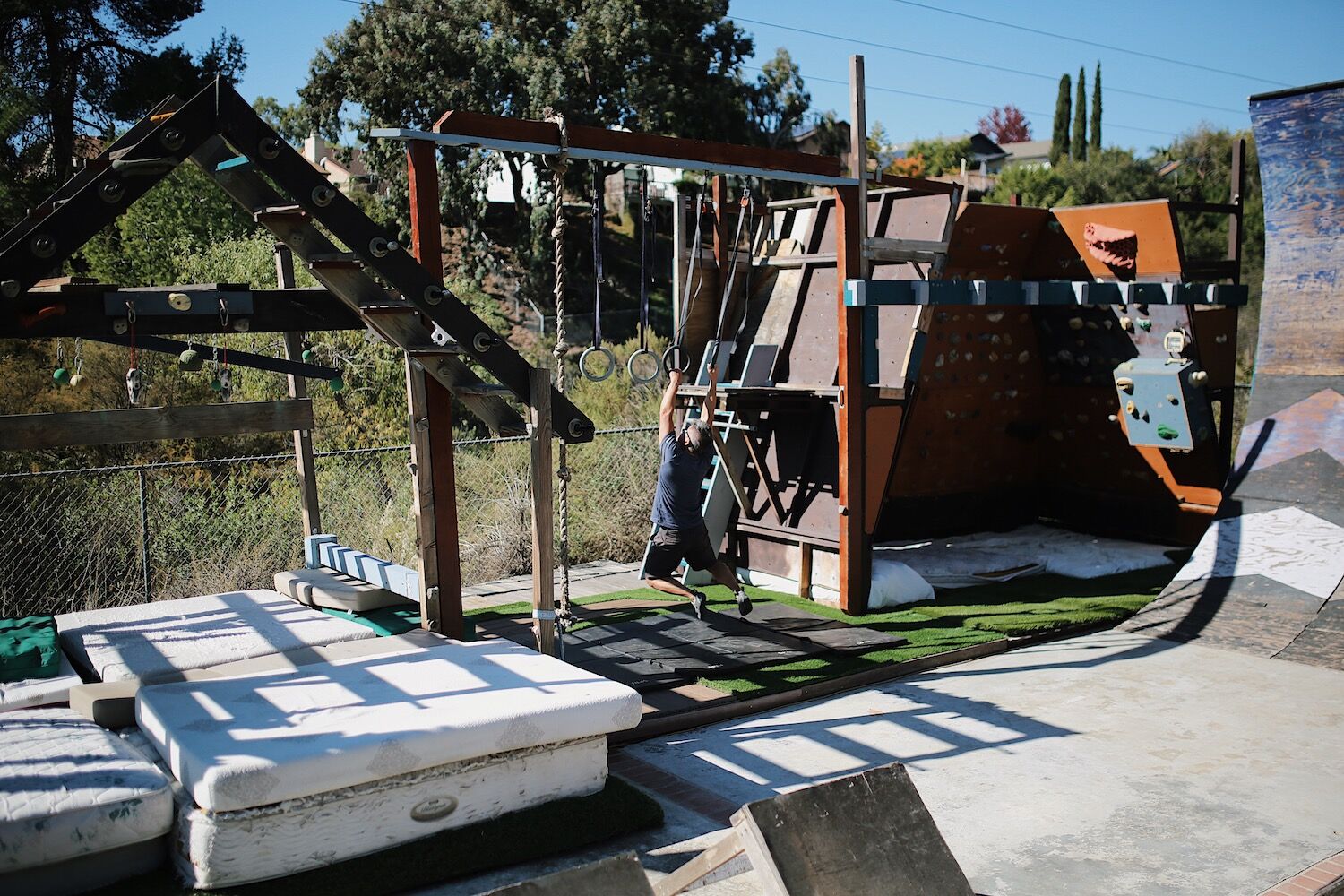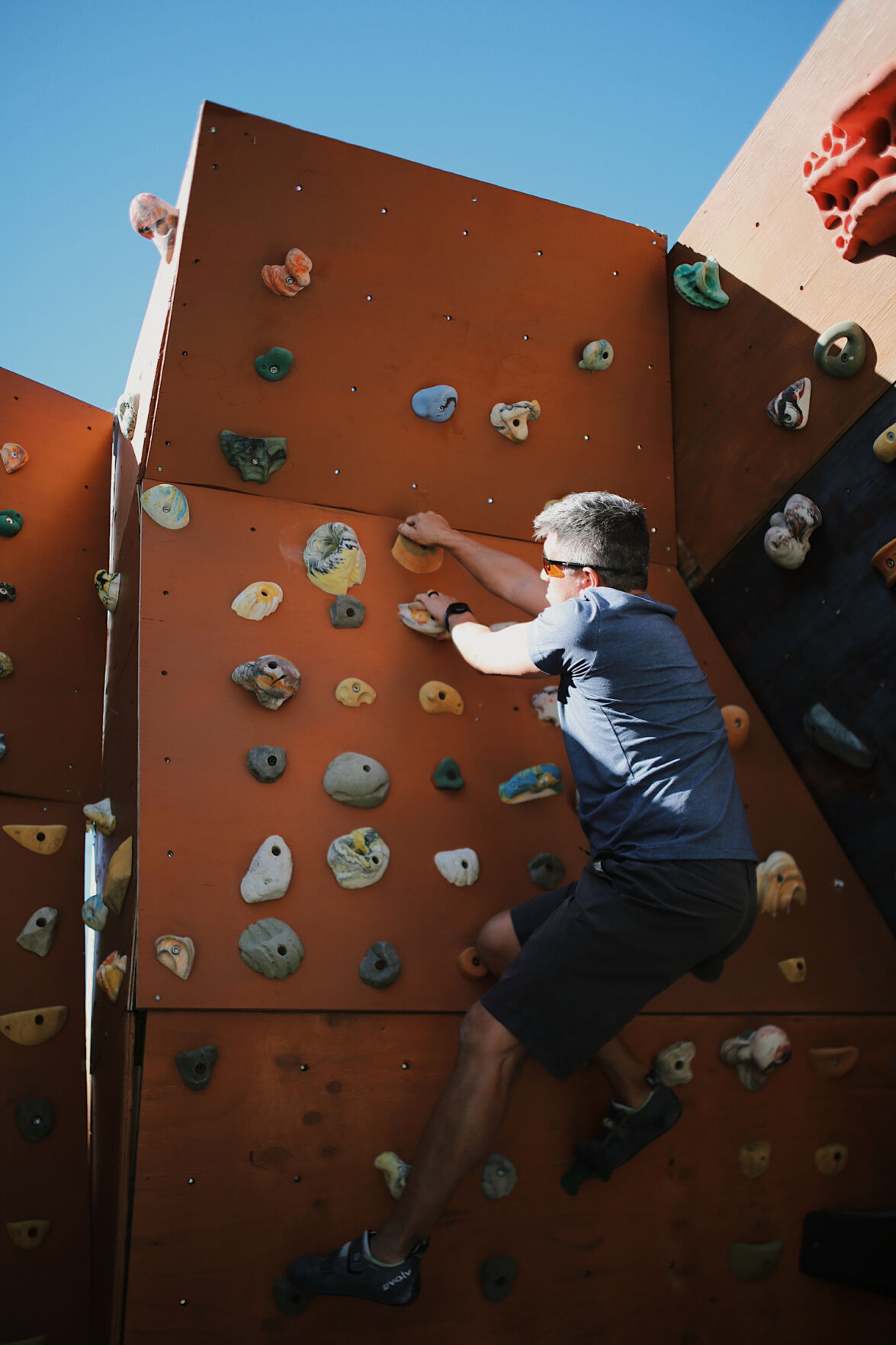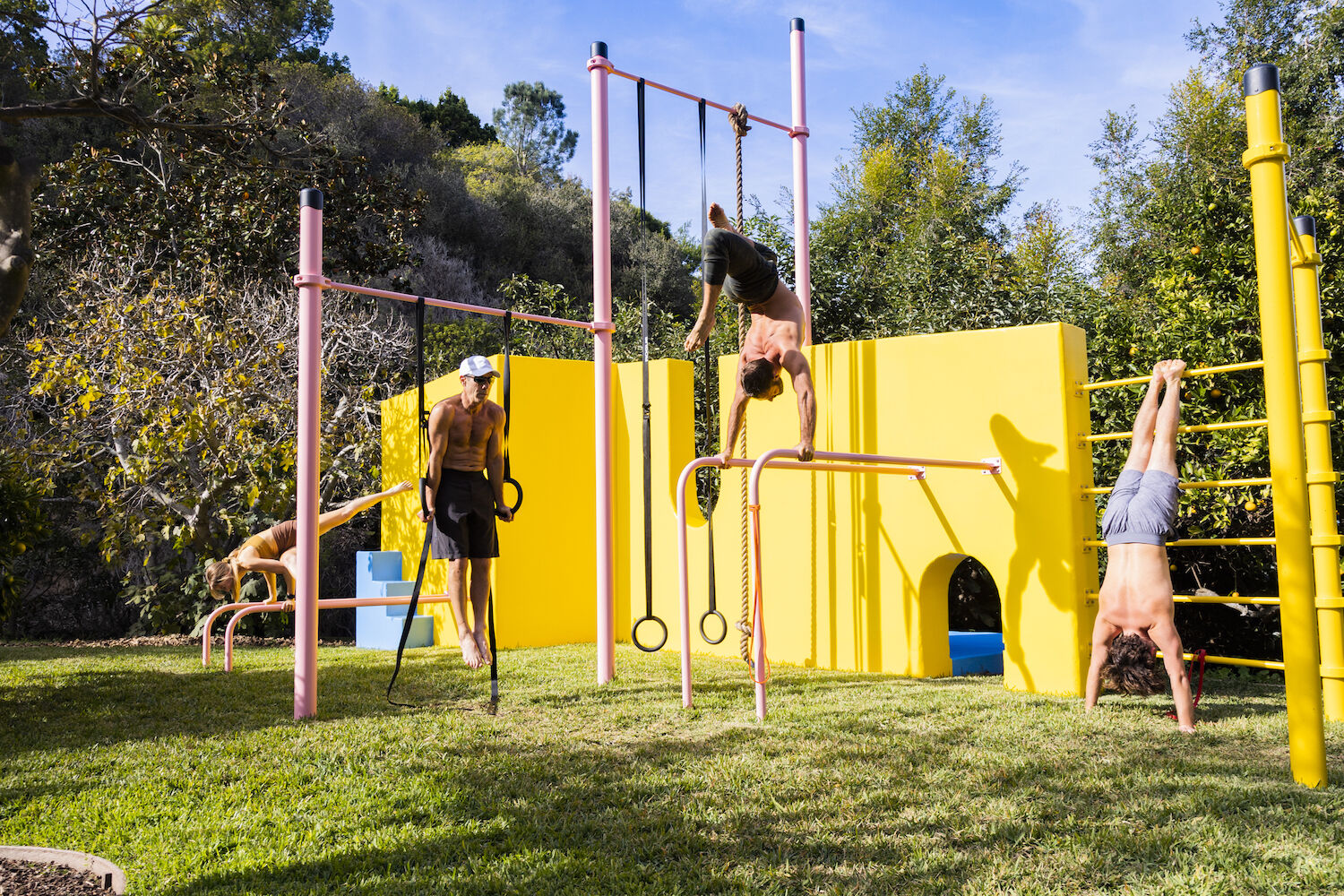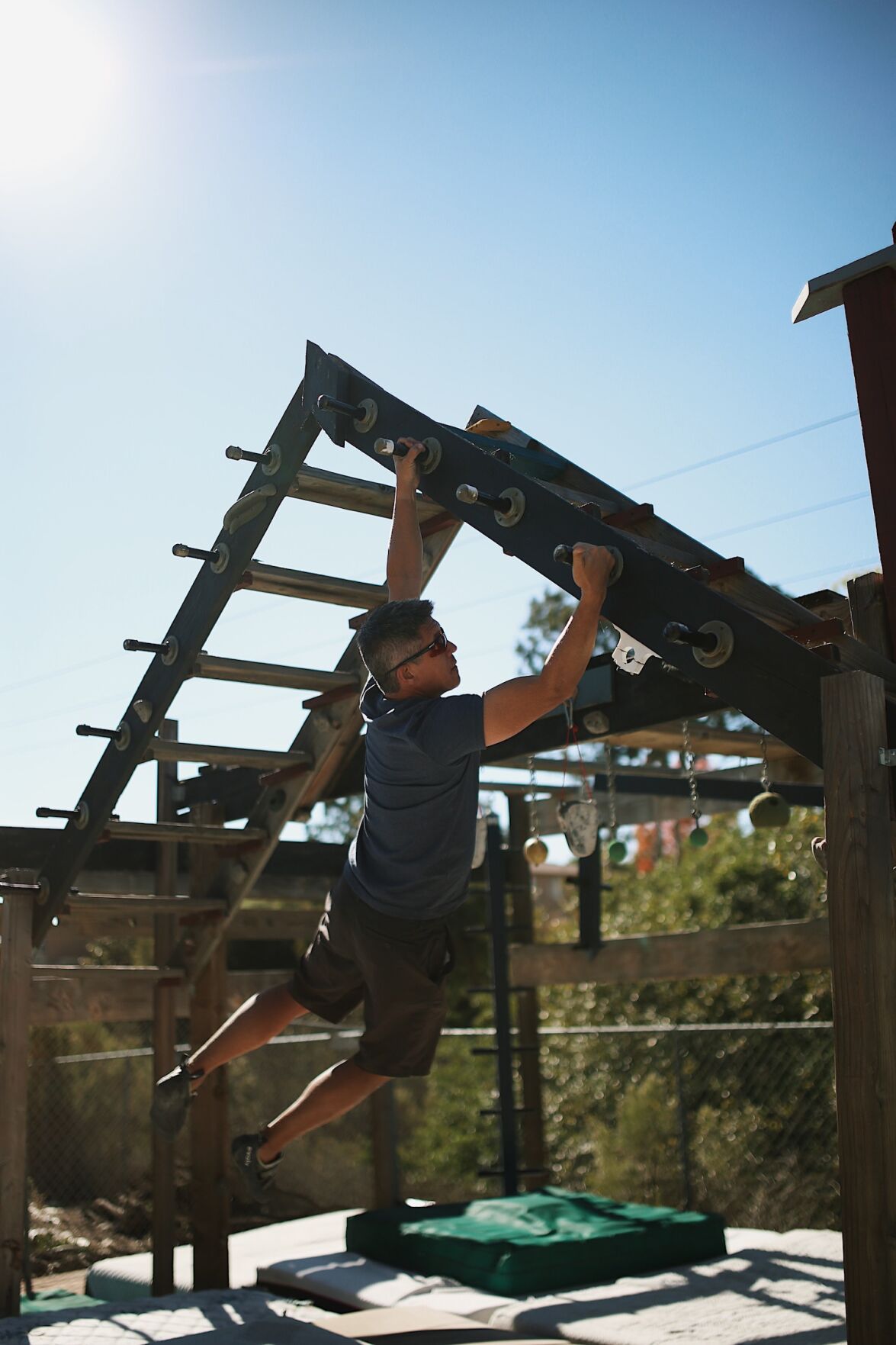
backyard gyms
Credit: Madeline Yang
Nestled deep in the expansive property of a La Jolla estate—past the tennis courts, past the pool, past a winding road and fruit trees—lies a concrete structure that looks like a slice of Swiss cheese.
But it’s no abstract sculpture. It’s highly functional, filled with every piece of exercise equipment a fitness junky could dream of—a rope for climbing, rings for acrobatics, a high bar for pull-ups, steps for aerobics or lunges, and a platform for handstands. It’s where Ed Rosen works out with his two 20-something sons almost every day.
Plenty of people have home gyms, maybe a treadmill or exercise bike and a few sets of weights lying around. Especially during Covid-19, people moved their exercise space to their homes, and for some, kept it there even as gyms reopened. But a select few have taken the concept of home fitness to a whole new level.

The Rosen’s backyard gym in La Jolla.
Photo Credit: Remy Haynes
“It’s an intergenerational playground for ages 0 to 150,” Ryan Rosen, the son who designed the workout space, says. “I love watching my grandma climb or crawl under the hole right there, which a four-year-old coined the secret door.”
The fact that it looks like playground equipment, with bright colors, little crevices to crawl through, and corners to hide in, is part of the point, says Ryan. In fact, it actually replaced an old jungle gym that had been languishing on the property since the Rosen boys were kids.
Covid lockdowns also inspired Leland Ferguson, whose Rancho Peñasquitos property includes a sloping canyon wall. He bought the place in 2018 and immediately thought about adding a ninja obstacle course his kids could use.

Leland Ferguson’s climbing wall in his Rancho Peñasquitos yard.
Photo Credit: Madeline Yang
Then, he started rock climbing, and when Covid shut down climbing gyms, he decided to build his own. “I built a 12-foot-high rock climbing wall in my backyard right next to the ninja course,” he said.
From there, the exercise space grew. After Ferguson completed a Tough Mudder race, he added two walls—one 12 feet and one 14 feet—to practice climbing over. Then he added a golf driving range and putting green. Next up, build a deck with a rock climbing wall underneath to practice climbing upside down.
Ferguson guesses he’s dedicated 100 days over the course of three years working on his space and has spent around $3,000 because most of the material he gets for free.
“I reclaimed wood that people were giving away, like old patio covers and whatnot,” he says. “So I basically built my structures for close to nothing just because I learned how to be really resourceful.”

backyard gyms, jungle gym
Credit: Madeline Yang
Now there are those who set up a home gym or buy a Peloton or treadmill and hardly ever use them. Ferguson is not one of those people. He uses his equipment all the time, though he has also returned to rock climbing gyms during his lunch breaks.
The trick, he says, is to not build something in the hopes that you’ll start using it but to find what exercise you love and then build space to do that type of exercise.
“I was already rock climbing anyway, and if the gyms are closed, I still want to climb, and so the only way to climb would be either go outside and find some rocks or build my own structure,” he says. “If you already enjoy cooking, of course you’re going to find a way to cook.
But if you don’t like cooking, I can’t just build you a $100,000 kitchen and expect you to make a great soufflé. It’s not going to happen. So I just built stuff that I knew that I was going to use. And because I like doing it in the first place, I’m going to use it.”

backyard gyms, yellow wall
Credit: Remy Haynes
And having easy access to the equipment helps him exercise more.
“I’m 51 now, and I climb with guys that are in their teens and 20s and 30s, and I’m able to keep up with them,” he says. “So it’s just a testament to, if you just make your house into a place of activity, then there’s no choice for you to just sit back on the couch and watch TV and drink Cutwaters.”
For Ed, a self-professed fitness addict, he’d be working out the same amount whether he had the equipment at his La Jolla home or not. But, he says, having the space on his property helps him be more efficient. And the equipment was built specifically for his fitness needs. He’s always trying new exercises instead of just lifting weights or doing the same cardio routines.
“The key is to confuse the body—use the equipment in all different ways, whether it’s doing lifts on the rings or high bar, doing skin the cats and pullovers, using strength and balance,” he says.
Ed plays sports, from skiing to tennis to pickleball, and says five years ago, he realized that to compete at a higher level, he should switch to gymnastics-based training. “In order to do those things at age 61,” he says hypothetically, “you have to cross train; otherwise, you’ll get hurt.”
But when Covid came, gyms closed, so Ed’s son Ryan offered to design the home fitness space. Ryan was also pursuing a master’s in architecture and used the project to launch his company, Friendly Futures, through which he aims to design more exercise spaces.

backyard gyms, climbing bars
Credit: Madeline Yang
“I want to create spaces that bring people together. I want to create spaces that encourage us to move and encourage us to play,” Ryan says. “We wanted to have these bright colors and bright forms to get people to come together. We want adults to have permission to crawl, to hang, to squat, to jump, to leap, to hop, to lie down, whatever is the verb that comes up.”
The structure at his parents’ house is made of concrete with steel bars and took three months to assemble. He estimates it cost between $40,000 and $60,000 to build. One of the best parts, Ryan says, is that having a home fitness setup means he and his family exercise together regularly and incorporate movement into their family routine. That also means that exercising doesn’t feel like a chore.
“I know for a lot of people, going to the gym is a chore, or it’s intimidating, or they don’t know what to do. But for us, it’s such a joy to come down here and work out,” he says.



















